

![]()
HERDING DOGS OF EASTERN EUROPE
THE HERDING DOGS OF HUNGARY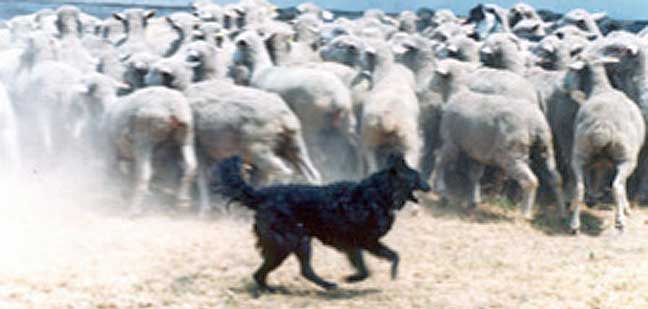
Above, a Mudi wearing at the back of a large flock of sheep. (Photo by Dr. Péter Pongrácz with kind permission from Celest Pongrácz.)
Fifty-six percent of Hungary consists of the Great Hungarian Plain. It is so vast that it has often been referred to as "The Endless Plain". Hungary has an ancient history in livestock breeding and also in herding dogs. However, long occupations and wars have interrupted the facts, and consequently the origins of the Hungarian herding breeds have been lost. Hungary has three different herding breeds, the Mudi, the Puli, and the Pumi; a fourth, the Sinka is a new breed; and a fifth, the Komondor, which is called a herdsman's dog, is used for droving and guarding, and is considered a livestock guardian dog (LGD). We will encounter the Komondor again in the pages on LGDs, but because of its history as a droving dog, we felt it belongs here as well. There is also a sixth breed related to sheep husbandry, the Kuvasz, a white LGD, which we will not cover here. Whether these breeds are related or not, whether one developed from another, or whether foreign breeds were used on indigenous herding dogs to produce these breeds are still questions that are debated in Hungary, questions that are as endless as the plain. Ancient Hungarian livestock, the Racka sheep with their long, twisted horns, and the tall, massively built Grey cattle with their enormous upward curving horns, have required robust, barking, herding dogs that are not afraid to bite when necessary, and all the Hungarian herding breeds exhibit these qualities.
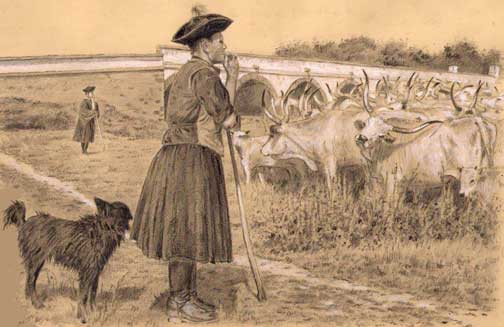 Left, a drawing of two Hungarian herdsmen tending cattle in Hortobágyi Nemzeti Park with their Mudi dog. (Artist unknown.)
Left, a drawing of two Hungarian herdsmen tending cattle in Hortobágyi Nemzeti Park with their Mudi dog. (Artist unknown.)
Hortobágyi Nemzeti Park, established in 1973 as the first national park in Hungary, is part of the Alföld or Great Plain and is a World Heritge site. Today it still looms as Hungary's largest protected region, with an area of almost 198,000 acres and more than 300 square miles. The largest semi-natural grassland in Europe, it provides grazing for herds of Hungarian Grey cattle, Taurus cattle (a cross between the German Heck cattle and southern-European primitive cattle breeds), Racka sheep, Water Buffalo, and horses, tended by herdsmen and their herding dogs.
Komondor
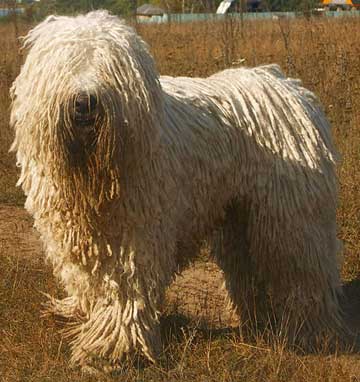 Right, a young Komondor. (Photo from Wikipedia by Nikki68 who published it under the following license: Permission is granted to copy, distribute and/or modify this document under the terms of the GNU Free Documentation License.)
Right, a young Komondor. (Photo from Wikipedia by Nikki68 who published it under the following license: Permission is granted to copy, distribute and/or modify this document under the terms of the GNU Free Documentation License.)
The Komondor was thought to have been brought to Hungary by the Cumans, nomadic warriors from the Eurasian Steppe who migrated to the Eastern European grasslands in the 11th century AD. The breed was known in Hungary at least since 1544 when it was mentioned in a Hungarian codex. The name Komandor means "Cuman dog". It is believed that the breed descends from Tibetan dogs. It is a large dog, many reaching over 30 inches tall, however, it is not a molosser-type. Most interesting is the Komandor's coat, which is made up of long (8-9.5 inches) corded or felted white hair that give the appearance of dreadlocks. The breed has a guardian temperament that can protect a flock from wolves and bears, and in days when sheep were driven long distances, this breed was also used as a drover's dog.
Mudi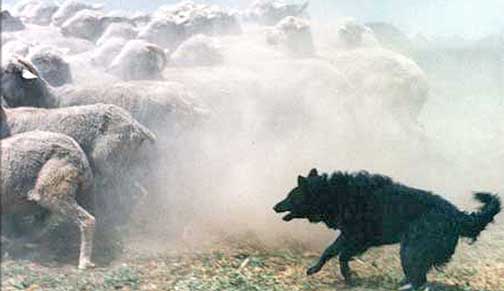
Above, a Mudi moving a large flock. (Photo by Dr. Péter Pongrÿcz with kind permission from Celest Pongrÿcz.)
The Mudi is a medium-sized dog, though a bit smaller than most of the others we have talked about in these articles, being between 12 and 18 inches. Its coat is rough and wavy or lightly curled. It has prick ears. The Mudi comes in many colors with interesting Hungarian names: recessive yellow (foko), merle (cifra), grey (or blue--hamvas), lilac, red (or brown--barna), black (fekete), and white (feher). It has a medium-length tail that is either left long or docked, and is often held curled over the back, or it sometimes has a naturally bobbed tail.
The Mudi is well adapted to Hungary's plains and harsh climate. It can herd cattle and pigs as well as sheep, though it is primarily a sheepdog. Today it is still used as both a sheep and cattle herder. Dogs that herd cattle are valued for their willingness to bite. For sheep work, the Mudi utilizes bark and rarely bites. Shepherds prefer dogs that bark only when necessary, however barking is often necessary because the huge flocks are often scattered on the plain. Unlike the circumstances of other European sheepdogs where the shepherd leads the flock and dogs patrol the flanks and rear, the Mudi works between the sheep and the shepherd, similar to the Border Collie, wearing and driving. The Mudi also has the gathering instincts very necessary on the large plain, and independent initiative.
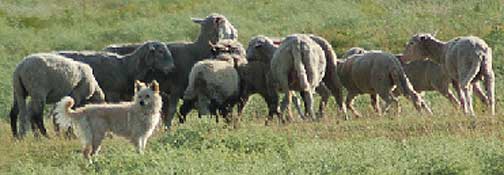 Left, a recessive yellow Mudi with a flock of sheep. (Photo courtesy of the Mudi Club of America.)
Left, a recessive yellow Mudi with a flock of sheep. (Photo courtesy of the Mudi Club of America.)
While there are still large flocks of sheep in Hungary, they are disappearing fast, similar to other countries, and with it the working Mudi. Advocates stress giving high priority to keeping herding instincts alive. Today, Mudik (the plural of Mudi) are shown in conformation, dog sports, obedience, tracking and schutzhund. According to Csaba Örkény, a trainer with extensive experience with Mudik, dogs that lose herding abilities and instinct "lack the willingness or ability for... quick and appropriate task solving". This may become a problem for all herding breeds in the future.
Puli
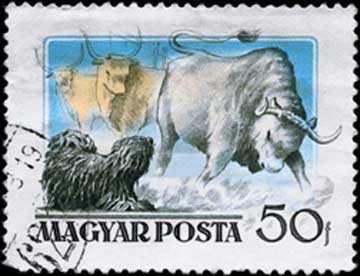 Left, a Hungarian postage stamp circa 1956 shows a Puli working Hungarian Grey cattle. Both dog and cattle are among the National Symbols of Hungary.
Left, a Hungarian postage stamp circa 1956 shows a Puli working Hungarian Grey cattle. Both dog and cattle are among the National Symbols of Hungary.
The Puli is a medium-sized dog whose coat is its most distinctive feature. Like the Komandor, above, the Puli's hair curls into naturally felted or corded dreadlocks which do not shed and grow continuously until they reach the ground if not clipped. In working dogs, harsh weather and environment keep the cords from achieving such length, but felting is protection from the elements. Another breed we have seen with a similar coat is the Italian Bergamasco. The Puli's coat comes primarily in black, but other less common colors are white, grey, and cream. Despite its heavy coat, the Puli is an agile breed that is used both for herding and guarding livestock, and tends to be fiercely protective of herd and flock.
The Puli is an ancient breed that may have come with the Magyars, also nomadic pastoralists, when they migrated from the Central Asian Steppe to the plains of Hungary more than a thousand years ago. However, the history of Hungary, and in particular, the history of the Magyars is very complicated. It would be difficult to attribute a specific breed to one particular player in the political games of such a complicated history. Advocates would like to trace their breed even 4,000 years further back to Asian herding dogs, but archaeology cannot identify a breed by its bones, as we have seen with other breeds. However, we can imagine that dogs with such weather-proof coats and protective natures would have served shepherds' needs well on the Eurasian Steppe. Only DNA will eventually tell what their true ancestry is.
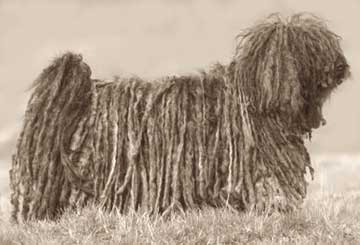 Right, a Puli with a full coat. Note how it reaches the ground.
Right, a Puli with a full coat. Note how it reaches the ground.
Early in the 20th century, extensive shepherding was replaced by intensive crop farming and the Puli's role was reduced. Yet, Pulik (the plural of Puli) are still used today to herd large flocks of sheep, and they are powerful, forceful, and vocal herders that work close to the shepherd and the sheep. They are loose-eyed dogs but rarely grip or bite except where needed. According to Puli World, "skills of the Puli, when in his own environment, include the ability to instantly lift an entire large flock, and to turn it [quickly]...Once on the move, he will join his shepherd at the rear of the flock to drive...A gesture from the shepherd will send him off to zip around the flock to tighten it up or turn it...". The Puli was never a popular pet due possibly to the care its coat requires, even though it is considered among the National Symbols of Hungary.
Pumi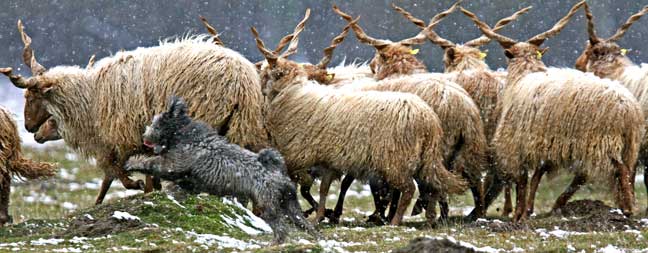
Hungarian Pumi herding Racka sheep. (Photo courtesy of Krisztina Menyhárt of Vörösköi-Kondacsipkedö).
The Pumi is a small to medium-sized (14-18") terrier-like dog that has been used for herding in Hungary and shares the strong nature of the other Hungarian herding breeds. It employs barking, nipping, wool tugging, and wearing to control its sheep, and the natural tenacity and drive of a terrier which compensates adequately for its relatively small size. It has a medium-rough, curly double coat with curly bearding on the face. Most are grey, but black, white and tan with a dark mask (known as maszkos fakó in Hungarian) are also known.
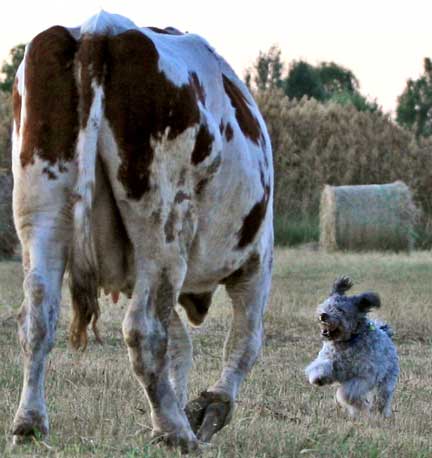 Left Pumi tackles a large cow, showing just how much spunk these little dogs have. (Photo courtesy of Krisztina Menyhárt of Vörösköi-Kondacsipkedö).
Left Pumi tackles a large cow, showing just how much spunk these little dogs have. (Photo courtesy of Krisztina Menyhárt of Vörösköi-Kondacsipkedö).
The Pumi originated in the 18th century when terrier-type herding dogs (possibly similar to the Kerry Blue and the Airedale, which have been occasionally used for herding) were brought to Hungary from Germany and France and crossed with Mudik and Pulik. These dogs came with the importation of Merino sheep. The resulting offspring were continually crossed with other herding dogs until the breed was recognized by the FCI in 1966, when cross breeding was no longer allowed. Pumik have been used as general farm dogs to guard the livestock, exterminate vermin, herd sheep, cows and pigs, and to some extent, even, for droving. Few are used for herding any more, and most can be seen in dog sports and conformation today.
Sinka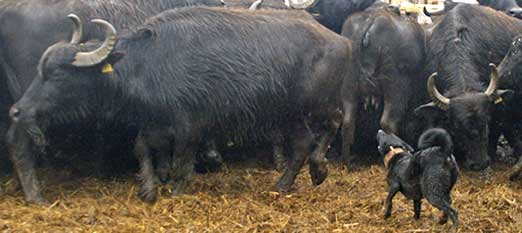
Above, a Sinka herding Hungarian Grey cattle. (Photo with kind permission from József Tari).
The Sinka seems to have been developed about 50 years ago in the Hortobágy region of eastern Hungary by crossing a number of different breeds. It is a smooth-coated dog with prick ears and a curled tail, which leads me to believe that it was a cross between the Mudi and a smooth-coated breed, perhaps not even another herding breed. The Boxer and the Bull Terrier have been mentioned. The Sinka's tail is held curled, sometimes double curled. The temperament of the breed is hard and aggressive. They are not a sensitive breed, and shepherds who use them prefer a really tough dog that they can correct with their crook and not have the dog run off. Shepherds believe that dew claws are a sign of a good working dog. The Sinka is the largest (save the Komondor) of the Hungarian herding breeds. Those used for cattle are larger and broader than the ones used for sheep. They are not currently recognized by any organization, and it is said that the shepherds prefer it to remain this way.
Below, a Sinka moving a small flock of Hungarian Racka sheep. (Photo with kind permission from József Tari).
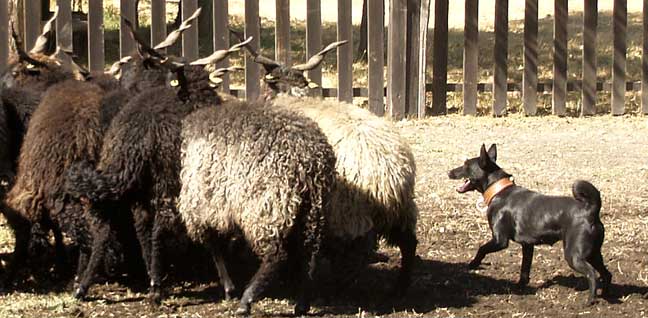
Copyright © 2014 by Carole L. Presberg
Resources:
Örkény, Csaba. "A Few Thoughts About the Future of Mudi Breeding in Hungary". This is also an excellent article, and a must-read for anyone interested in the future of herding dogs in general (www.americanmudiassociation.org/page-26.html#ANCHOR_Text4).
Menyhárt, Krisztina. Všršsköi-Kondacsipkedö Pumik (www.kondacsipkedo.hu)
Mudi Club of America (http://www.mudi.us/pb/wp_42ba9320/wp_42ba9320.html).
Pongrácz, Dr. Péter and Celest Spadavecchia. "The Mudi, Hungary's 'Driver Dog' ", the American Herding Breed Association Events Bulletin, Jan/Feb 2006 Edition. This is an excellent article which should be read by everyone interested in the Mudi and the future of herding dogs in general (www.americanmudiassociation.org/mudiherding_final.pdf).
Puli World: "The Herding Puli" (www.puliworld.com/puliworld/herding.html).
Tari, József. "Sinka, a Hungarian Sheep Dog--From My Point of View" (http://www.netboard.hu/viewtopic.php?topic=22814&x_p=2).
Wikipedia: "Hortobágy" (en.wikipedia.org/wiki/Hortob%C3%A1gy).Wikipedia: "Hungary" (en.wikipedia.org/wiki/Hungary).
Wikipedia: "Komondor" (en.wikipedia.org/wiki/Komondor).
Wikipedia: "Mudi" (en.wikipedia.org/wiki/Mudi).
Wikipedia: "Puli" (en.wikipedia.org/wiki/Puli).
Wikipedia: "Pumi" (en.wikipedia.org/wiki/Pumi_%28dog%29).
Return to
![]()
BORDER COLLIE COUSINS
THE OTHER WEB PAGES WE MAINTAIN
These web pages are copyright ©2014
and maintained by webmeistress Carole Presberg
with technical help from webwizard David Presberg
ALL RIGHTS RESERVED
If you are interested in using ANY material on this website, you MUST first ask for permission.